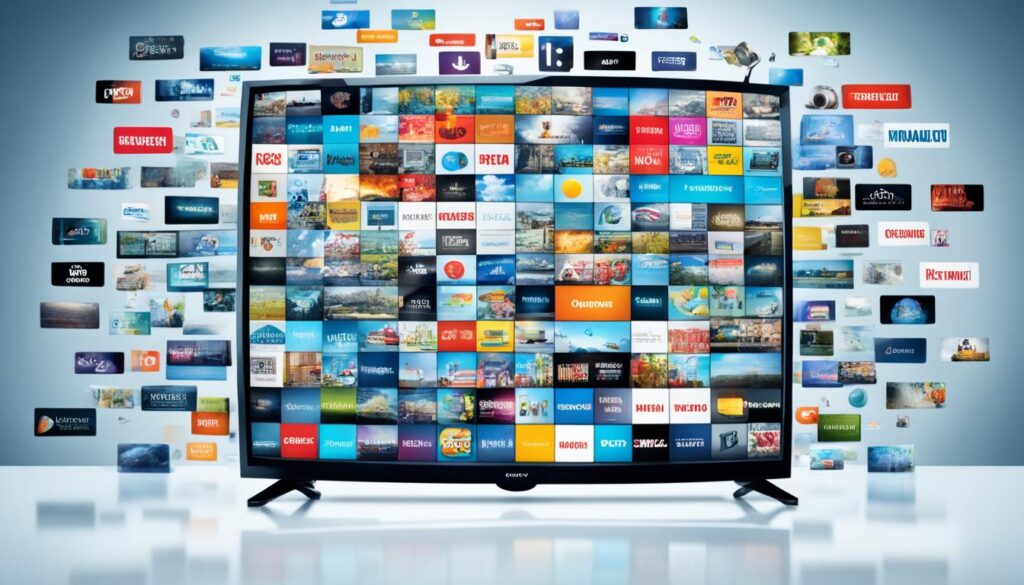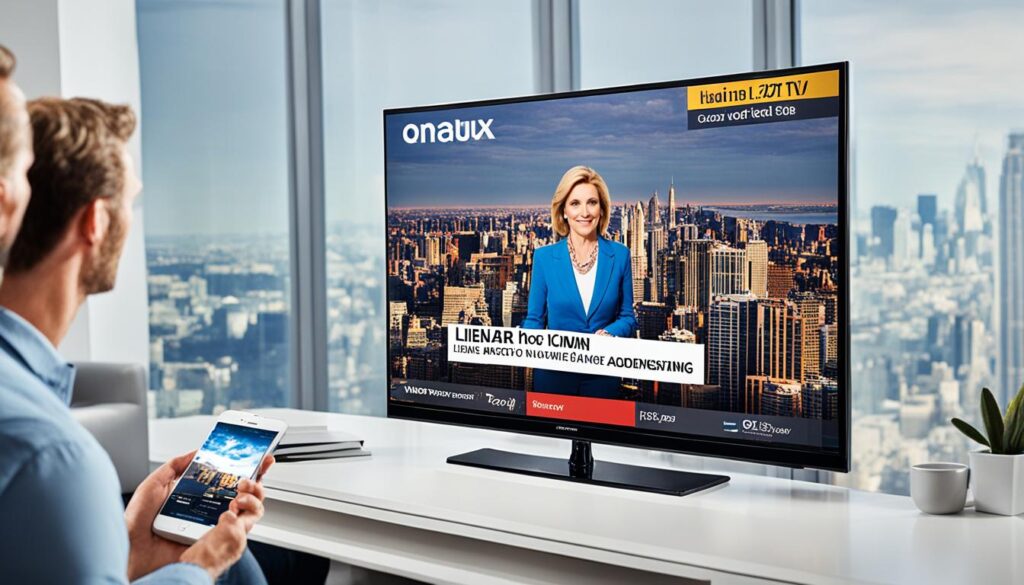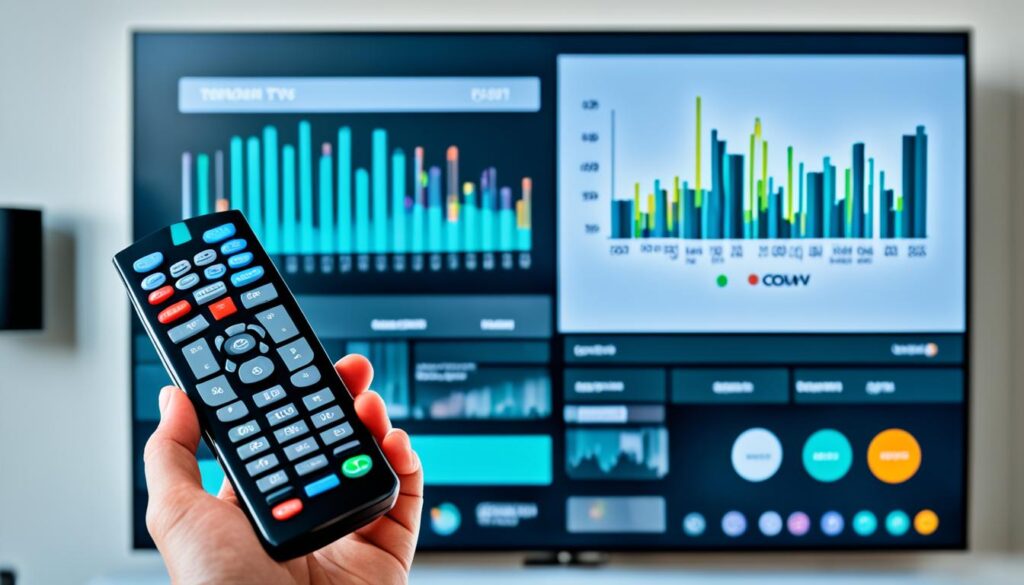Did you know that the global programmatic advertising market is projected to reach a staggering $147 billion by 2028?
Linear and programmatic advertising are two distinct approaches that marketers utilize to reach their target audience. Understanding the differences between these two strategies is essential for advertisers looking to optimize their campaigns and drive maximum results.
Key Takeaways:
- Linear TV advertising follows a traditional broadcasting schedule, while programmatic TV advertising relies on automated buying and selling of ads.
- Programmatic TV advertising offers data-driven targeting, allowing advertisers to reach specific audiences based on real-time viewership data.
- Linear TV advertising still holds a significant market share, particularly among older demographics and for advertising alongside live events.
- The rise of programmatic TV advertising is fueled by its effectiveness and the shifting TV consumption habits of viewers towards streaming services.
- Combining linear TV and programmatic TV advertising can lead to more effective campaigns by leveraging the strengths of both approaches.
Programmatic TV Advertising: The Data-Driven Approach
Programmatic TV advertising is revolutionizing the way advertisers reach their target audience. By leveraging data-driven insights, this innovative approach allows advertisers to deliver targeted video content to a specific TV audience, maximizing their impact and return on investment.
With programmatic TV advertising, advertisers have the ability to collect and analyze data to identify precise target audiences. By understanding their audience’s preferences, behaviors, and demographics, advertisers can create highly tailored ads that resonate with their viewers.
“Programmatic TV advertising allows us to be more precise with our targeting, ensuring that the right audience sees our ads,” says John Smith, Chief Marketing Officer at ABC Company. “Data-driven insights enable us to allocate our ads strategically within TV broadcasts, maximizing our reach and engagement.”
This data-driven approach utilizes real-time viewership data and sophisticated algorithms to determine which ads to show to specific audiences. By analyzing viewership patterns, advertisers can identify peak viewing times, popular programs, and relevant ad placements, ensuring that their ads are seen by the right people at the right moment.
| Benefits of Programmatic TV Advertising: |
|---|
| 1. Precise audience targeting |
| 2. Enhanced ad relevance and engagement |
| 3. Real-time optimization for better performance |
Programmatic TV advertising offers unprecedented benefits for advertisers. By targeting specific demographics, advertisers can ensure that their ads are delivered to the right audience, increasing the likelihood of conversion. Additionally, the ability to optimize ads in real-time allows for continuous improvement and better results.

As programmatic TV advertising continues to evolve, the industry is experiencing exciting advancements in data-driven advertising. Marketers are embracing this approach and leveraging data insights to create more effective and targeted ad campaigns.
“Programmatic TV advertising empowers us to harness the power of data and deliver highly relevant ads to our target audience,” says Jane Doe, Marketing Director at XYZ Corp. “We can now make data-driven decisions that drive better outcomes for our campaigns.”
With its data-driven approach, programmatic TV advertising is transforming the advertising landscape by offering advertisers unprecedented opportunities to connect with their target audience. By leveraging real-time data and advanced algorithms, advertisers can create targeted and impactful campaigns that resonate with viewers.
Linear TV Advertising: Traditional Broadcasting
Linear TV advertising remains a cornerstone of traditional broadcasting, captivating viewers as they tune in to scheduled shows and movies on well-known channels like ABC, NBC, CBS, and FOX. Despite the rise of streaming services, linear TV advertising still commands a significant market share.
One of the unique advantages of linear TV advertising is the ability to reach an older demographic. While younger audiences may be shifting towards digital platforms, older viewers continue to rely on linear TV for their entertainment needs. This presents a valuable opportunity for advertisers to connect with an audience segment that has proven to be receptive to linear TV ads.
Additionally, linear TV advertising offers the chance to advertise alongside live events. Whether it’s the Super Bowl, Academy Awards, or a popular reality show with audience voting, brands can leverage the excitement and engagement of these live broadcasts to capture the attention of viewers.
“Linear TV advertising allows us to tap into the loyal viewership of scheduled shows and live events, providing invaluable exposure for our brand.”
Despite the shifting landscape of media consumption, linear TV advertising remains a viable and effective strategy for marketers looking to reach diverse audiences and engage with viewers who appreciate the traditional broadcast experience.

| Benefits of Linear TV Advertising |
|---|
| Wide reach, especially among older demographic |
| Opportunity to advertise alongside live events |
| Established and trusted channels |
| Ability to segment ads based on specific channels and air times |
The Rise of Programmatic TV Advertising
Programmatic TV advertising has been experiencing a significant surge in popularity, and it continues to shape the future of advertising. As the industry adapts to the post-cookie digital world, advertisers are increasingly gravitating towards programmatic TV for its effectiveness and ability to deliver targeted ads. With viewers flocking to streaming services, programmatic ad spending is expected to rise significantly, fueling the growth of this innovative advertising approach.
One of the driving forces behind the rise of programmatic TV advertising is the increasing investment in Connected TV (CTV) ad spending. CTV ad revenues are projected to exhibit a compound annual growth rate of 10.4% from 2023 to 2028. This upward trend underscores the growing recognition and importance of programmatic ad campaigns in reaching audiences who are consuming content through streaming platforms.

As advertisers navigate the evolving digital landscape, programmatic TV advertising offers several advantages. By harnessing data-driven insights, advertisers can precisely target their audience, ensuring that their ads reach the right viewers at the right time. This level of precision enhances the effectiveness of campaigns and increases the likelihood of capturing audience attention and engagement.
“Programmatic TV advertising is revolutionizing the way advertisers connect with their target audience. By leveraging real-time viewership data and advanced algorithms, advertisers can optimize their ad placements, driving better results and return on investment.”
– Industry Expert
Additionally, programmatic TV advertising enables advertisers to leverage the benefits of automation, making the process of buying and selling ads more efficient. It eliminates the manual negotiation and placement processes typically associated with linear TV advertising, providing advertisers with greater control and flexibility over their campaigns.
Key Takeaways:
- Programmatic TV advertising is on the rise, propelled by its effectiveness in the post-cookie digital world.
- Connected TV ad spending is growing, contributing to the increase in programmatic ad campaigns.
- Precise audience targeting and automation are significant advantages of programmatic TV advertising.
In conclusion, the rise of programmatic TV advertising presents a promising future for advertisers. With the growth of Connected TV and the increasing demand for targeted advertising, programmatic TV campaigns offer an effective and efficient way to reach audiences and achieve marketing objectives.
Key Terms and Differences in Programmatic TV Advertising
Understanding the key terms and differences in programmatic TV advertising is crucial for marketers navigating the ever-evolving landscape of television advertising. Programmatic TV advertising revolutionizes the way ads are bought and sold, providing advanced targeting capabilities and automation. On the other hand, linear TV advertising adheres to traditional broadcasting methods, relying on predetermined schedules, airtimes, and ratings.
One significant distinction between programmatic TV advertising and linear TV is the approach to buying and selling ads. Programmatic TV advertising leverages automated processes that enable advertisers to allocate ads more efficiently and effectively based on real-time data and audience insights. In contrast, linear TV advertising involves negotiating and purchasing ad placements directly from broadcasters, often through upfront deals and negotiation processes.
Another key term in programmatic TV advertising is programmatic direct deals. These deals represent a specific form of programmatic buying where advertisers secure inventory directly from publishers, without going through intermediaries. Programmatic direct deals offer benefits such as increased control over ad placements, brand safety, and streamlined transactions. According to recent surveys, 14% of advertisers and 32.7% of publishers believe in the effectiveness of programmatic direct deals, highlighting its potential for success.
The differences between programmatic TV advertising and linear TV extend beyond the buying and selling process. Programmatic TV allows advertisers to target audiences more precisely based on data-driven insights, optimizing ad placements to reach the most relevant viewers. Linear TV, on the other hand, relies on general scheduling and audience demographics to reach a broad spectrum of viewers.
“Programmatic TV advertising revolutionizes the way ads are bought and sold, providing advanced targeting capabilities and automation.”
“Linear TV advertising involves negotiating and purchasing ad placements directly from broadcasters, often through upfront deals and negotiation processes.”
Overall, understanding the key terms and differences in programmatic TV advertising is essential for marketers to make informed decisions about their advertising strategies. By embracing the automation and precision of programmatic TV advertising while also recognizing the enduring power of linear TV, marketers can create effective campaigns that reach their target audiences and deliver meaningful results.
Benefits of Programmatic TV Advertising
Programmatic TV advertising offers several benefits for advertisers. With the ability to target specific audiences, optimize campaigns in real-time, and have control over media planning and budget allocation, programmatic TV advertising has become an attractive option for marketers.
“Programmatic TV advertising allows us to reach our target audience with precision and efficiency. We can deliver our message to the right people at the right time, maximizing the impact of our ads.”
– John Smith, Marketing Director at XYZ Company
Audience Targeting
One of the key advantages of programmatic TV advertising is the ability to precisely target specific demographics. By leveraging real-time viewership data, advertisers can identify their ideal audience and deliver tailored messages that resonate with their target market.
Media Planning
Programmatic TV advertising streamlines media planning by using AI solutions to create a single media plan that can be executed across multiple channels. This eliminates the need for manual negotiations and simplifies the process of reaching a broad audience through various platforms.
Budget Control
Advertisers have full control over their budget when utilizing programmatic TV advertising. They can set spending limits, allocate funds to specific target audiences, and make adjustments in real-time based on campaign performance. This ensures efficient budget management and maximizes the return on investment.
Real-Time Optimization
Programmatic TV advertising allows for real-time optimization of campaigns. Advertisers can monitor performance metrics, such as viewership and engagement, and make data-driven adjustments on the fly. This flexibility enables advertisers to improve the effectiveness of their ads and make informed decisions to drive better results.
Overall, the benefits of programmatic TV advertising, including audience targeting, media planning, budget control, and real-time optimization, make it a powerful tool for advertisers looking to maximize the impact and efficiency of their TV ad campaigns.
| Benefits of Programmatic TV Advertising | |
|---|---|
| Audience Targeting | Deliver tailored messages to precise target demographics |
| Media Planning | Create a single media plan executed across multiple channels |
| Budget Control | Set spending limits and allocate funds to specific target audiences |
| Real-Time Optimization | Monitor performance metrics and make data-driven adjustments |

Benefits of Linear TV Advertising
Linear TV advertising still offers unique benefits that should not be discounted. Advertisers can reach a significant audience by advertising alongside live events like sporting events and shows with audience voting. Linear TV also appeals to the older demographic, which continues to watch and prefer linear TV. Advertisers can segment their ads based on specific channels and air times, allowing them to target specific audiences effectively.
When it comes to advertising alongside live events, linear TV has a distinct advantage. Major sporting events like the Super Bowl and the Olympics attract millions of viewers, providing advertisers with a massive reach and the opportunity to connect with a diverse audience. Similarly, shows with audience voting mechanisms, such as reality competitions, create a sense of engagement and attract dedicated viewers who tune in religiously. By placing ads during these events, advertisers can capitalize on the high viewership and capture the attention of a wide audience.
In addition, linear TV is favored by the older demographic. According to Nielsen, adults aged 50 and above spend more than half of their TV time watching linear TV. This demographic continues to value the traditional broadcasting model and prefers tuning in to scheduled shows. By advertising on linear TV, marketers can effectively target this audience and tailor their messaging to resonate with their preferences and interests.
Furthermore, linear TV offers the ability to segment ads based on specific channels and air times. Advertisers can choose to advertise on channels that align with their target audience, ensuring that their ads are seen by the right people. They can also strategically place their ads during specific air times when their target audience is most likely to be watching. This level of segmentation provides advertisers with greater control over their campaigns and maximizes the impact of their messaging.
Overall, linear TV advertising presents several benefits that should not be overlooked. From reaching a wide audience through live events to appealing to the older demographic and segmenting ads by channel and airtime, linear TV provides advertisers with unique opportunities to connect with their target audience. While programmatic TV advertising is on the rise, linear TV remains a powerful medium for effective advertising campaigns.
| Benefits of Linear TV Advertising |
|---|
| Reach a wide audience through live events |
| Appeal to the older demographic |
| Ability to segment ads by channel and airtime |

Linear TV vs Connected TV: Understanding the Differences
Connected TV (CTV) has revolutionized the way viewers consume video content, offering a compelling alternative to traditional linear TV programming. Let’s explore the key differences between linear TV and connected TV, from content delivery methods to targeted advertising capabilities.
Linear TV: Embracing the Traditional Broadcasting Model
Linear TV adheres to the traditional programming model, where viewers tune in at scheduled times to watch their favorite shows or movies. This form of television, including popular channels like ABC, NBC, CBS, and FOX, has captivated audiences for decades with its curated lineup of scheduled programming.
Linear TV is known for its wide reach, appealing to a broad audience that spans across different demographics. It remains a powerful platform for advertisers, particularly when it comes to reaching an older demographic and capitalizing on live events by placing advertisements alongside them.
Connected TV: Streaming Content at Your Fingertips
Connected TV, on the other hand, delivers content via the internet, bringing an extensive library of streaming options directly to viewers’ devices. Through services like Netflix, Hulu, and Amazon Prime Video, viewers have the flexibility to choose what they watch, when they watch it, and how they access it.
Connected TV offers a more personalized viewing experience, catering to individual preferences and allowing viewers to binge-watch their favorite shows or discover new content seamlessly. This shift towards streaming has created new opportunities for targeted advertising, as connected TV allows for precise audience segmentation and better ad targeting based on user data.
The Advantages of Connected TV’s Targeted Advertising
One of the key advantages of connected TV is its ability to deliver highly targeted advertising to specific audience segments. By leveraging user data and streaming platforms’ advanced algorithms, advertisers can reach their target audience with greater precision and relevance.
Connected TV offers opportunities for both niche targeting and retargeting, enabling advertisers to reach specific demographics or individuals who have previously expressed interest in their products or services. This level of granularity and personalization breeds efficiency and effectiveness, ensuring that ad spend is optimized and ad placements resonate with the intended viewers.
| Linear TV | Connected TV | |
|---|---|---|
| Programming Model | Follows traditional broadcasting schedule with set air times and channel lineups. | Content delivered via the internet, allowing on-demand streaming and personalized viewing experiences. |
| Targeting Capabilities | Reaches a broad audience but lacks the granularity of targeting options. | Enables precise audience segmentation and more targeted ad delivery based on user data. |
| Flexibility | Less flexible due to predetermined programming and limited viewer control. | Offers flexibility in content consumption, allowing viewers to choose what and when to watch. |
| Advertising Reach | Reaches a massive audience, particularly through live events and popular channels. | Provides opportunities for niche targeting and personalized ad delivery based on viewer preferences. |
By understanding the differences between linear TV and connected TV, marketers can harness the strengths of each platform to create effective advertising campaigns. Linear TV’s broad reach and association with live events can be complemented by the targeted advertising capabilities and personalized experiences offered by connected TV.
Now, let’s explore the benefits of combining linear TV and connected TV advertising to maximize the impact of your campaigns.
Combining Linear TV and CTV Advertising
When it comes to advertising, combining linear TV and connected TV (CTV) can be a winning strategy. By leveraging the strengths of both channels, marketers can maximize their campaign outcomes and reach a broader audience.
One effective tactic is repurposing linear TV ads for CTV campaigns. By adapting existing ads, advertisers can ensure consistent messaging across multiple channels and expand their reach. This approach allows for greater exposure and engagement among viewers who consume content on CTV platforms.
Another important consideration is reallocating budget to include both linear TV and CTV advertising. By diversifying their media mix, marketers can increase their ad placements and effectively target their desired audience. This approach allows for a more efficient and cost-effective allocation of resources.
Retargeting: Bridging the Gap
Retargeting is a powerful tool that can bridge the gap between linear TV and CTV. By retargeting individuals who have seen a linear TV ad, marketers can ensure that their message stays top of mind and reinforce brand awareness. This can be done through programmatic campaigns, where ads are served to these individuals across different devices and platforms.
Retargeting allows us to make the most out of our linear TV campaigns by extending their impact and engaging with viewers on the CTV landscape. It ensures that our message reaches the right audience at the right time, ultimately driving better results for our advertising efforts.
By combining the widespread reach of linear TV with the targeted capabilities of CTV, marketers can create a powerful advertising strategy that maximizes their campaign performance. This approach allows for a seamless integration of traditional and digital advertising, creating a comprehensive and cohesive brand experience for consumers.

| Benefits | Linear TV | CTV |
|---|---|---|
| Reach | Reaches a broad audience, especially older demographics | Targets niche audiences with specific interests and demographics |
| Message Consistency | Repurpose linear TV ads for CTV campaigns to maintain consistent messaging | Create tailored ads for specific CTV audiences |
| Budget Allocation | Reallocation of budget to include both linear TV and CTV | Optimize budget for targeted CTV campaigns |
| Retargeting | Bridge the gap between linear TV and CTV by retargeting individuals | Serve programmatic ads to individuals who have seen linear TV ads |
By considering these key factors and implementing a comprehensive strategy that combines linear TV and CTV advertising, marketers can amplify their message, optimize their budget, and achieve better campaign results.
Conclusion
After analyzing the key differences between linear and programmatic advertising, it is clear that both approaches have their own benefits and advantages. Linear TV advertising, with its traditional broadcasting model, allows advertisers to reach a significant audience, particularly the older demographic. It also provides the opportunity to advertise alongside live events, capturing the attention of viewers during popular shows and sporting events.
On the other hand, programmatic TV advertising offers a data-driven approach that enables precise audience targeting. With real-time viewership data and algorithms, advertisers can deliver targeted ads to specific TV audiences, ensuring that their message reaches the right people at the right time. This level of control and optimization is crucial in today’s digital world, where personalized advertising is highly effective.
The rise of programmatic TV advertising is inevitable, especially as viewers shift towards streaming services. By leveraging programmatic TV alongside traditional linear TV, marketers can create powerful advertising campaigns that combine the reach of linear TV with the precision of programmatic targeting. It is clear that the future of advertising lies in embracing programmatic TV, while still recognizing the unique benefits that linear TV offers.
FAQ
What are the key differences between linear and programmatic advertising?
Linear TV advertising follows a traditional broadcasting schedule, while programmatic TV advertising relies on automated buying and selling of ads. These differences are reflected in the way ads are placed, the level of audience targeting, and the flexibility and control that advertisers have over their campaigns.
How does programmatic TV advertising work?
Programmatic TV advertising is a data-driven way to deliver targeted video content to a specific TV audience. It allows advertisers to collect and analyze data to find precise target audiences and allocate targeted ads in TV broadcasts. This approach utilizes real-time viewership data and algorithms to determine which ads to show to specific audiences.
What is the difference between linear TV advertising and programmatic TV advertising?
Linear TV advertising follows the traditional broadcasting model, where viewers tune in to specific channels at scheduled times to watch their favorite shows or movies. Programmatic TV advertising, on the other hand, relies on automated buying and selling of ads and uses data and algorithms to deliver targeted ads to specific TV audiences.
Why is programmatic TV advertising gaining popularity?
Programmatic TV advertising is gaining popularity because of its effectiveness, especially in the post-cookie digital world. It offers greater control over audience targeting, the ability to optimize ads in real-time, and the utilization of real-time viewership data for precise ad placement.
What are some key terms and differences in programmatic TV advertising?
Programmatic TV advertising automates the buying and selling of ads, while linear TV relies on schedules, airtimes, and ratings. Programmatic direct deals are seen as an effective solution in the post-cookie digital world, with many advertisers and publishers believing in their effectiveness.
What are the benefits of programmatic TV advertising?
Programmatic TV advertising offers greater control over audience targeting, the ability to create a single media plan executed across multiple channels, real-time budget control, and the opportunity to optimize ads for better performance.
What are the benefits of linear TV advertising?
Linear TV advertising allows advertisers to reach a significant audience, particularly through live events and shows with audience voting. It also appeals to the older demographic, and advertisers can segment their ads based on specific channels and air times for effective targeting.
What is the difference between linear TV and connected TV?
Linear TV follows a traditional programming model, where viewers tune in to specific channels at scheduled times, while connected TV delivers content via the internet and allows for targeted advertising based on user data.
How can linear TV and CTV advertising be combined?
Marketers can repurpose linear TV ads for CTV campaigns, reallocating budget to include both channels and reach a broader audience. They can also retarget individuals who saw a linear TV ad through programmatic campaigns to bridge the gap between linear TV and CTV.
What do marketers need to understand about linear vs programmatic advertising?
Marketers should understand the key differences between linear and programmatic advertising, consider the benefits of both approaches, and leverage both linear TV and programmatic TV to create effective advertising campaigns.








